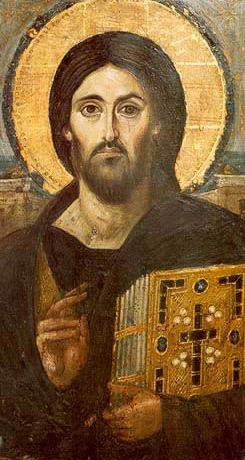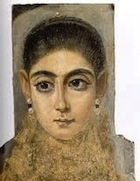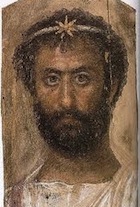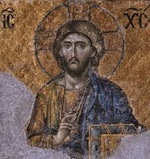
Christ as Pantocrator, meaning “Almighty, All Powerful,” is the Greek word used by Paul to describe the Lord in II Corinthians 6:18 and by John nine times in the Book of Revelation: 1:8; 4:8; 11:17; 15:3; 16:7; 16:14; 19:6; 19:15 and 21:22. This is the oldest known painting of Jesus of Nazareth. It was once dated to the 1200’s, but after it was cleaned in 1962 and the original encaustic layer exposed, it was re-dated to the 500‘s under the reign of Emperor Justinian (527-565). Justinian had founded St. Catherine’s Monastery on Mt. Sinai, Egypt and it was under his reign that this type of religious iconography was first created.
Encaustic (from the Greek word “enkaustikos” meaning “to burn in”) painting is, also, known as hot wax painting—heated beeswax to which colored pigments are added and then applied to a surface. Encautic painting with wax, hot or cold, as a medium goes back thousands of years. Dioscorides (40-90 AD), in De Materia Medica 2.105 describes how cold Punic  Wax used in painting was made. The mummy portraits found at Fayum in Egypt dating to the late centuries BC, early centuries AD are breathtaking examples of the Punic Wax technique. As can be seen from the ages of the many mummies, life was brief in the ages before modern medicine.—CLICK HERE for article on Longevity in the Ancient World
Wax used in painting was made. The mummy portraits found at Fayum in Egypt dating to the late centuries BC, early centuries AD are breathtaking examples of the Punic Wax technique. As can be seen from the ages of the many mummies, life was brief in the ages before modern medicine.—CLICK HERE for article on Longevity in the Ancient World
 There is another famous mosaic of the Pantocrator in the Hagia Sophia, once a church, then a mosque and now a museum, in Istanbul, Turkey. The mosaic was done in the 1260’s and the resemblance to the 500’s Pantocrator is uncanny, leading some to believe that the artist had seen or had access to the St. Catherine painting done 700 years previously.—Sandra Sweeny Silver
There is another famous mosaic of the Pantocrator in the Hagia Sophia, once a church, then a mosque and now a museum, in Istanbul, Turkey. The mosaic was done in the 1260’s and the resemblance to the 500’s Pantocrator is uncanny, leading some to believe that the artist had seen or had access to the St. Catherine painting done 700 years previously.—Sandra Sweeny Silver
Music from Taize: Benedictus Qui Venit—3 minutes
The Benedictus Qui Venit is a musical round (each voice sings exactly the same words and melody but begins at different times to create pleasing harmony). The words in the Benedictus come from Luke 19:38 and Psalm 118:26. The English translation of the Latin is:
